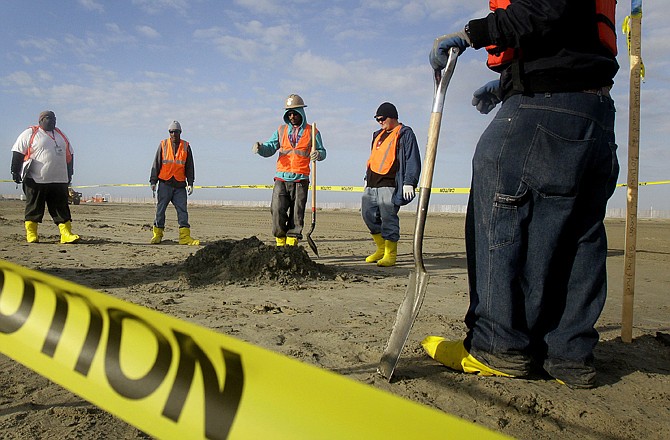EAST GRAND TERRE ISLAND, La. (AP) - Dig 2 feet into the sand on this wind-swept beach and up comes the foul smell of oil.
The unmistakable whiff of crude eight months after the BP spill is one of the last in-your-face reminders of the long, tainted summer on the Gulf Coast.
For months, in what BP calls Operation Deep Clean, crews have been scouring the Gulf Coast's sandy shores for oil - digging, scraping, tilling and sifting beach after beach.
But it's unlikely they will get all of it by the time college students begin flocking to the Gulf Coast for spring break at the end of February, the Coast Guard's deadline for cleaning bathing beaches. There is so much oil under the sand, mud and oyster shells that tar balls may be washing up for months, if not years.
"This process goes on and on over time," said Ed Overton, a Louisiana State University chemist who has analyzed the spill for the federal government. "You clean them up, they come back, you clean them up."
The Coast Guard says 928 miles of beach were fouled with oil and fewer than 30 miles are left to clean.
In many places, tar balls and black sticky patties that once littered the shoreline are gone. The sand is no longer stained brown, and the surf is clear of crude. Beaches that once looked like excavation sites are returning to normal.
"It's at that mopping-up stage for a lot of the beaches," said Edward H. Owens, a technical adviser for BP and veteran of the cleanup of the 1989 Exxon Valdez spill in Alaska.
At the spill's height, 47,000 people and over 10,000 vessels were working on the disaster. Now, the army of spill responders is down to 6,000 and the fleet consists of about 380 vessels.
Yet on this stretch of befouled Louisiana coast - a bird sanctuary, not a bathing beach - the cleanup seems far from over. On East Grand Terre, workers in orange safety vests use backhoes and mechanical augers to dig up the sand, which is sifted and resifted by machines with conveyor belts and screens.
"You definitely smell it. It hits you in the face," Toney Edison, a BP cleanup worker, said as he inspected a new hole.
Spring break isn't big business on the Louisiana and Mississippi coast, but it is along the Florida Panhandle and parts of Alabama. There, the beach cleanup is nearly complete.
On Pensacola Beach, Fla., crews in white hard hats and yellow vests scoot across the sand on motorized carts, looking for any oily debris. Bulldozers scoop up sand and put it into yellow dump trucks that haul it away as large tractors rake the sand into neat rows.
Bruce Parris, manager of The Dock restaurant and bar, said his place saw a 60 percent slump in sales over the summer. Now he is looking forward to Mardi Gras, spring break and next summer.
"Our beaches are clean," Parris said. "They're as pretty as they've ever been."

